Nothing wrecks a favorite shirt faster than surprise paint stains. Maybe the kids went big with acrylics, or a DIY wall job splattered more than expected.
Now there is a bold mark on the fabric and stress kicks in. Here is the good news, quick action raises the odds of full paint stain removal. Different paints need different moves, so matching the method to the mess matters.
Want those jeans back in rotation? Keep reading. It is easier to deep clean it than it looks.
Key Takeaways
- Move fast. Treating wet stains within minutes works far better than waiting for dried paint stains.
- Identify the paint type first. Water-based paint responds to cold water and dish soap, while oil-based paint needs a solvent.
- Check the care tag before any treatment and spot test products like rubbing alcohol on a hidden seam.
- Skip heat. Dryers and irons set stains, making both water-based and oil-based marks much harder to remove.
- Still stuck after home care? Use a dry cleaner, especially for dry clean only pieces.
What to Do Before Removing Paint from Clothes
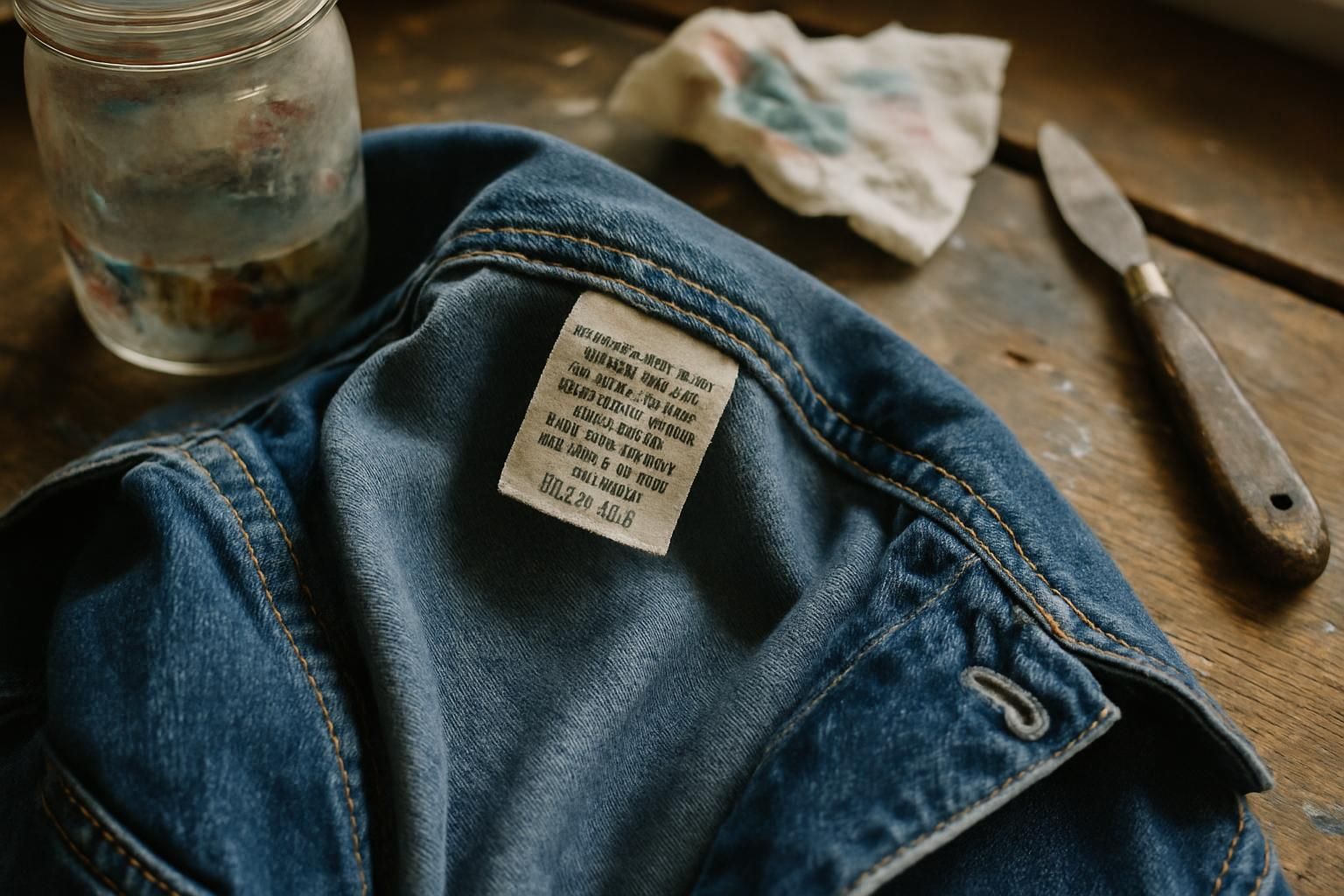
Grab the care tag before grabbing the stain remover. A quick check saves fabric and time, especially with acrylic paint and latex paints that behave differently from oil-based blends.
Assess the type of paint
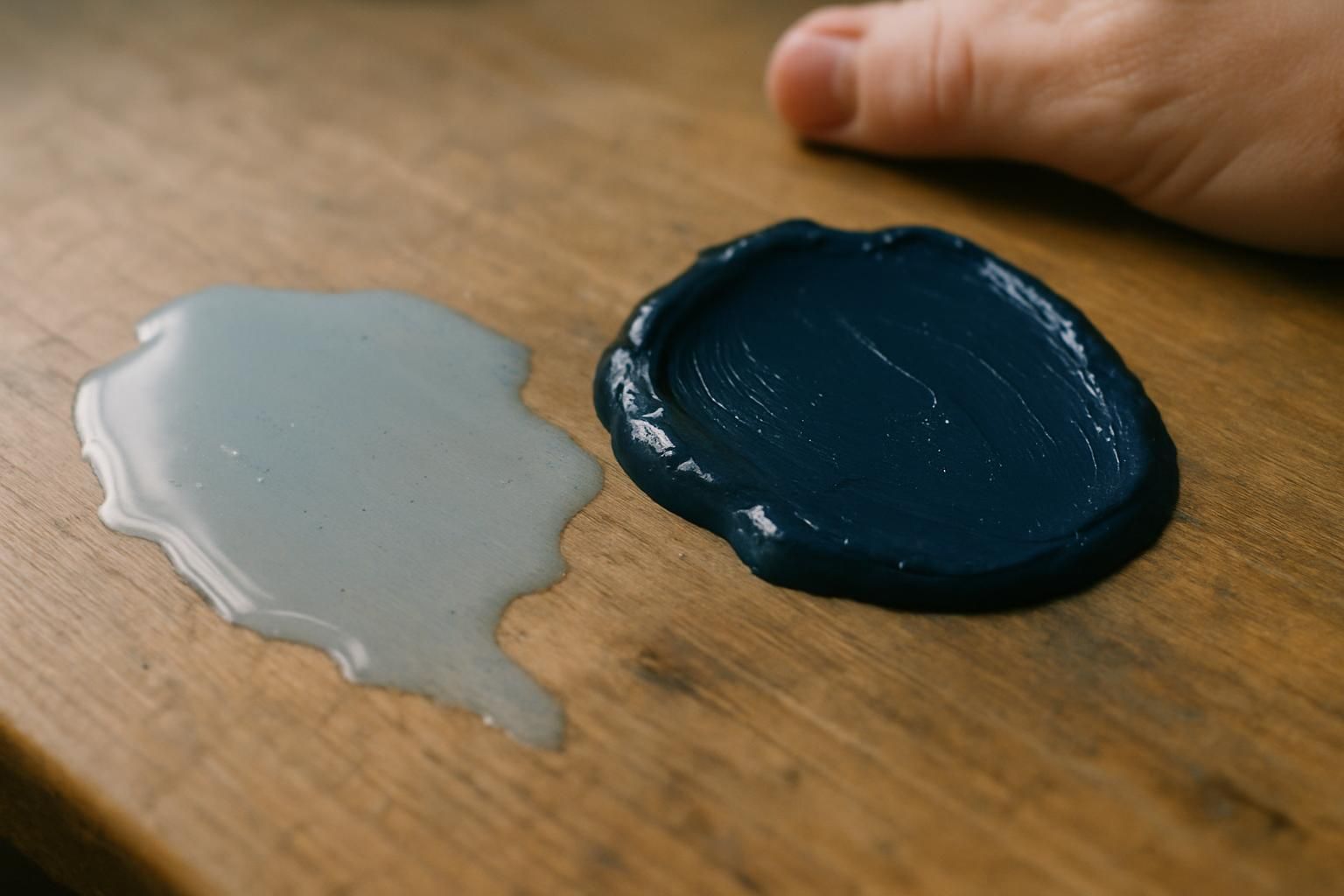
Most craft paints, including acrylic paint and latex paint, are water-based. These usually lift with cold water and a little laundry detergent or dish soap.
Oil-based paint is more stubborn. It often needs a solvent like mineral spirits, turpentine, or acetone to break it down. Getting this ID right guides every next step and keeps favorite clothes from extra damage.
Quick tip: water activates water-based paint, so treat it while still damp. Oil-based paint grips fabric like glue, so expect more patience and careful handling.
Check the care label of the garment

After choosing the paint type, scan the washing symbols on the tag. These icons tell whether the item can handle warm water, bleach, or a standard washing machine cycle. Cotton is tough. Silk and rayon are not.
âDry clean only means skip home solvents. For hand wash only, start gentle, think dish soap and cool water. Always spot test stain remover like isopropyl alcohol or non-acetone nail polish remover on a hidden seam. If color shifts or the fibers fuzz, stop and consider professional care.
Act quickly for better results
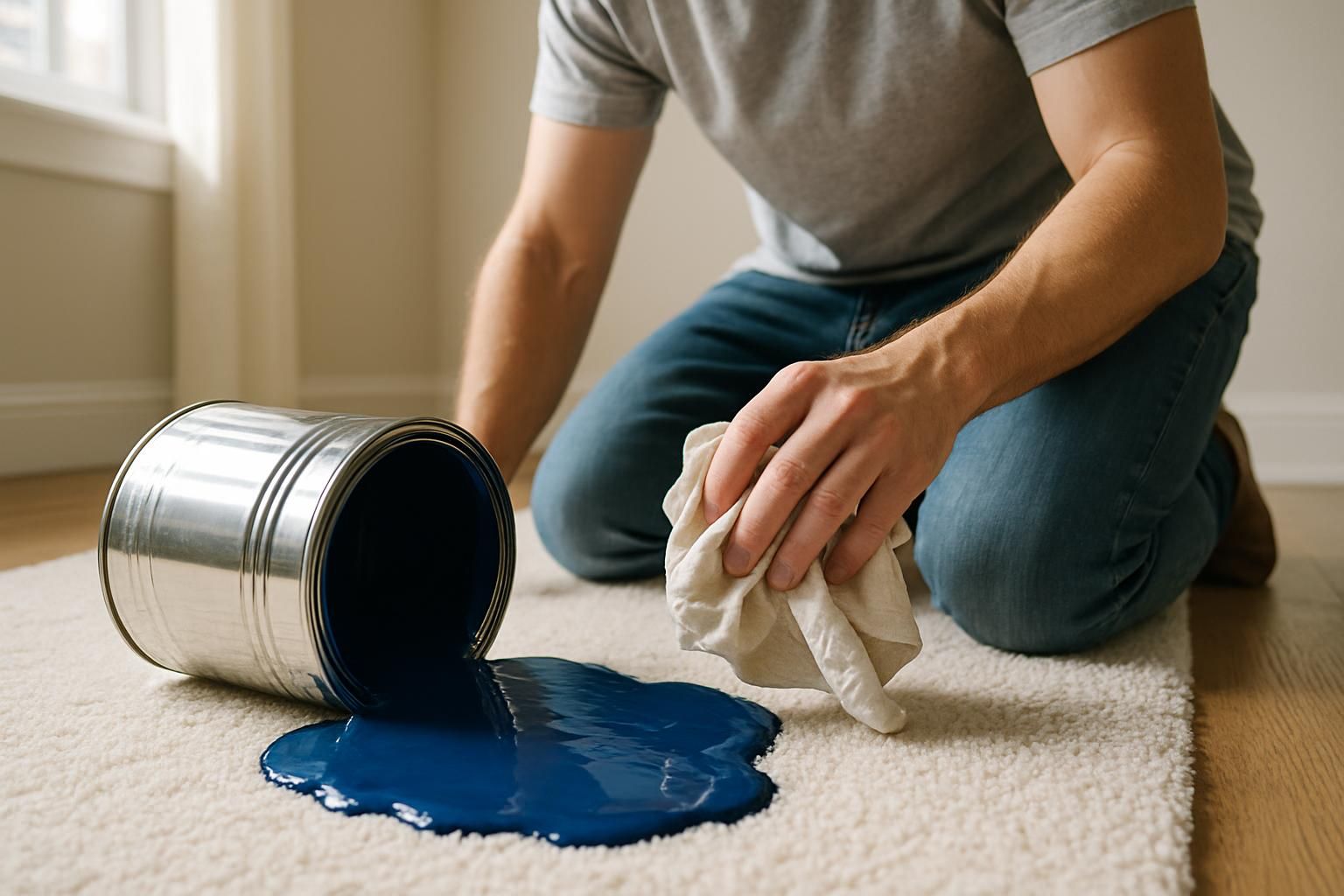
Fresh stains are beatable. Blot right away with a clean cloth or paper towel to keep paint from sinking deeper into the fibers. Cold water helps keep water-based paint from setting.
Waiting even 30 minutes lets pigments grab on. Treating wet acrylics early bumps success rates way up. A small effort now saves a long battle later, and it prevents a bad surprise in the washing machine.
How to Get Water-Based Paint Out of Clothes
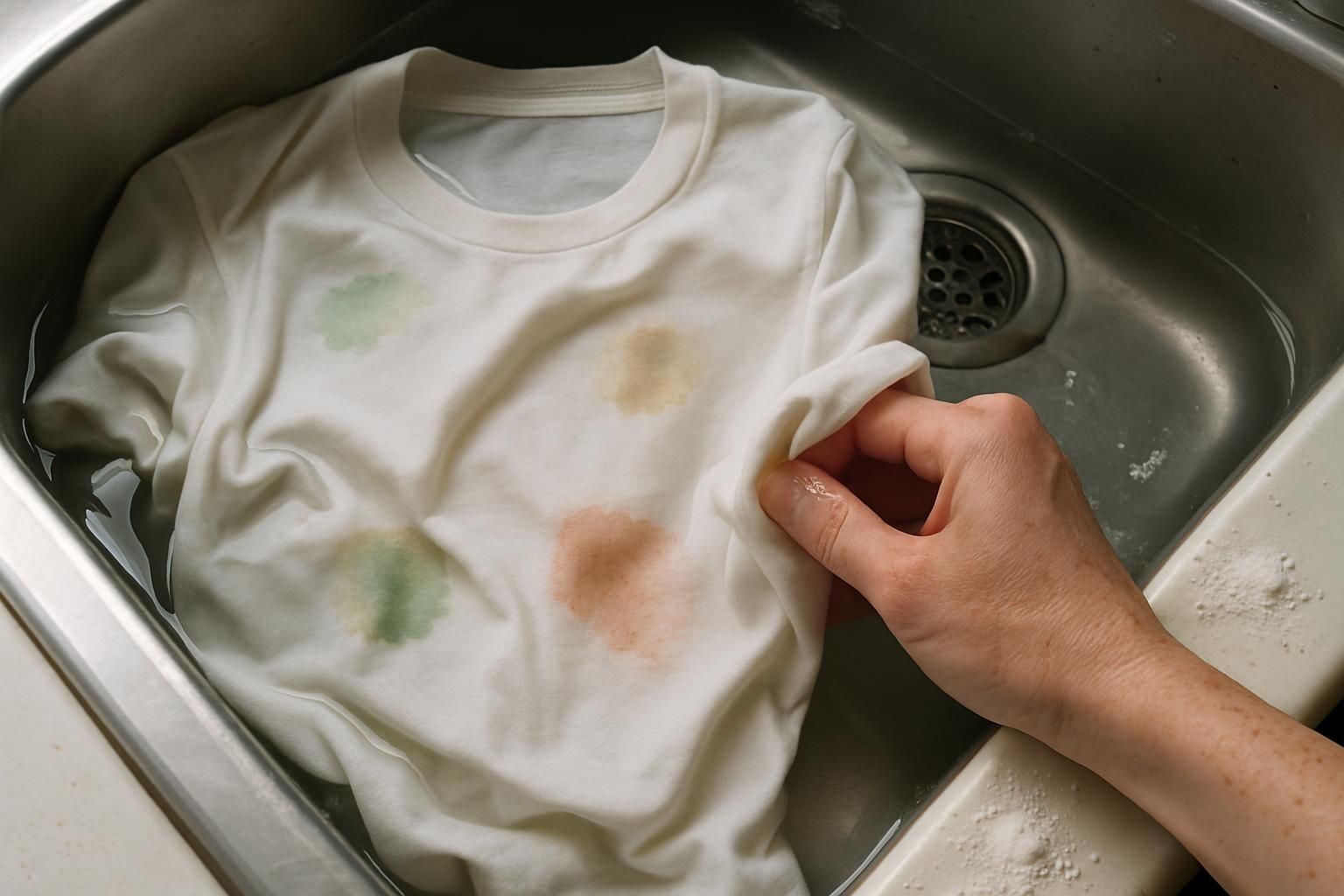
Water-based paint, including latex paint and many acrylics, usually cleans up with patience and simple supplies. Think dish soap, cold water, and a little stain remover if needed.
Step 1: Remove excess paint
Use a spoon or dull butter knife to lift off any blobs before they dry. Work from the outside edge toward the center to avoid spreading the mess.
Go easy on delicate fabrics like silk or rayon. Rough scraping can stretch or snag the weave. Drop scraped bits on a paper towel so the floor does not join the party.
Step 2: Rinse the Stain with Cold Water
Use cold water first, not warm. Hold the fabric under the faucet and flush from the back of the stain. This pushes pigment out instead of deeper in.
Rub gently with fingers or a soft cloth while rinsing. Keep going until the water runs clearer. If the stain is already dry, skip this rinse and go straight to soap so heat does not lock it in.
Step 3: Apply detergent or dish soap
Dot the spot with liquid dish soap or laundry detergent, fragrance free if possible. Work up a light lather with a damp cloth or sponge.
Blot, then check the progress. Rinse with cold water and repeat as needed. Short sessions work better than one marathon scrub, and they protect the fibers.
Step 4: Use stain remover
Cover the stain with a fabric-safe stain remover. Oxygen bleach works well on colors because it is gentler on dyes, while chlorine bleach should be limited to white cotton.
For extra help, make a paste of baking soda and water and massage it into the mark before using a commercial product. Always test an inside seam first. If color transfers to the cloth, pause and pick a safer option.
Step 5: Wash and inspect the garment
Wash on a regular cycle with the temperature allowed on the care tag. Warm water can help if the label says it is safe.
Check the spot before drying. Heat sets paint, so air dry if any stain remains. If needed, repeat soap and stain remover, then wash again. Rinse well after using solvents so odors and residue do not linger.
How to Get Oil-Based Paint Out of Clothes

Oil-based paint sticks hard, but it is beatable with the right approach. Plan on a solvent step, then soap, then a solid wash for best results.
Step 1: Blot the stain from the back of the fabric
Lay the fabric face down on clean paper towels. Blot from the back with a fresh cloth to pull paint outward and into the towels, not deeper into the fabric.
Work from the edges toward the center. Switch to clean spots on the cloth often so old paint does not smear back on.
Step 2: Apply a solvent like turpentine or paint thinner
Use a small amount of turpentine, paint thinner, or mineral spirits for tough oil-based paint stains. Wear gloves and ventilate the space well. These liquids can irritate skin and create strong fumes.
Test on a hidden seam first. If safe, dab the stain with a solvent dampened cloth until the paint loosens. Keep the area well aired and take breaks if the smell is strong.
Step 3: Add detergent and soak overnight
After solvent, cover the spot with dish soap and massage gently. Fill a sink or bucket with hot, soapy water and let the garment soak overnight. Heat helps break down oily residue, but only use the hottest water allowed on the tag.
Some stains need more than one soak. If the fabric is delicate or labeled cold wash only, use cooler water and extend the time.
Step 4: Rinse and wash the garment
Rinse with cold water to remove loosened paint and solvent. Then wash on the warmest temperature the care tag allows. A normal cycle and quality detergent usually finish the job.
Inspect after washing and air dry. If any mark remains, repeat the rinse and wash. Avoid the dryer until the stain is fully gone.
How to Remove Dried Paint from Clothes
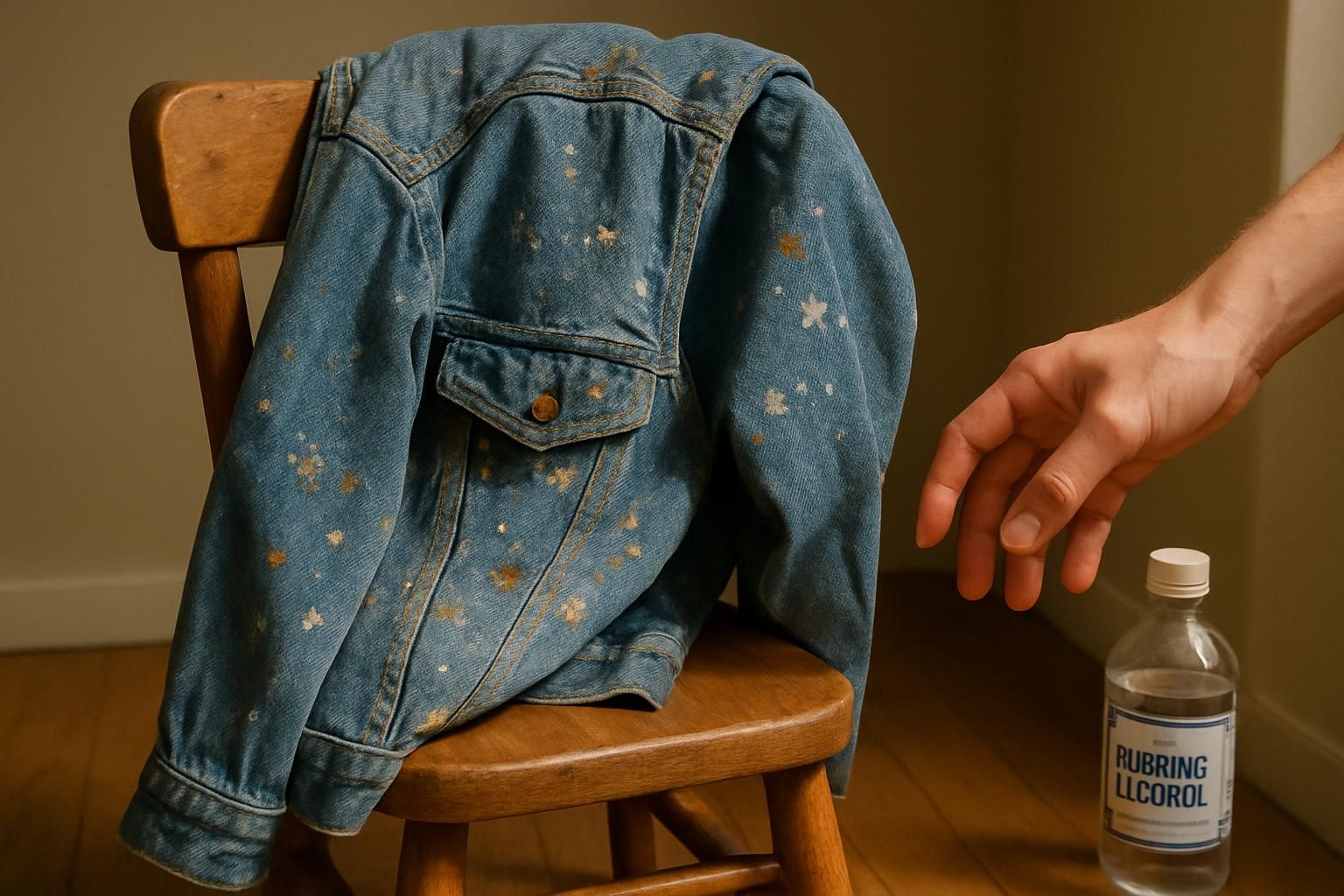
Dried paint acts like it owns the fabric, but patience still wins. Start mechanical, then move to liquids.
Scrape off excess dried paint
Place the garment face down on paper towels. Gently scrape with a spoon or soft brush to lift any crusty bits. Avoid tearing the fibers or grinding color deeper.
Blot with a white cloth to grab loose pigment. A quick rinse can help remove dust-like flakes before the next step on latex paint or acrylic paint.
Use warm water and dish soap for water-based paint
For water-based paint stains like latex or acrylic, soak the spot with warm water and rub in dish soap or laundry detergent. A soft toothbrush helps work soap into the weave without roughing up the fabric.
Blot, rinse, and repeat. Let soapy water sit for ten minutes on stubborn paint stains, then scrub again. Always spot test bright or dark colors first.
Apply rubbing alcohol or paint thinner for oil-based paint
Rubbing alcohol, also called isopropyl alcohol, loosens many dried oil-based marks. Press a soaked cotton ball onto the stain, working from the outside in. For extra tough spots, use paint thinner or mineral spirits with care.
Test on a hidden seam and keep ventilation strong. Replace paper towels often and avoid skin contact. Repeat until the fabric lifts clean.
Wash thoroughly after treatment
Wash the treated item alone. Follow the care tag for temperature and cycle. An extra rinse helps clear leftover solvent and pigment.
Air dry and recheck under good light. Heat sets remaining color, so do not use the dryer until the stain is truly gone. If needed, repeat spot treatment and wash again.
Important Tips for Paint Removal
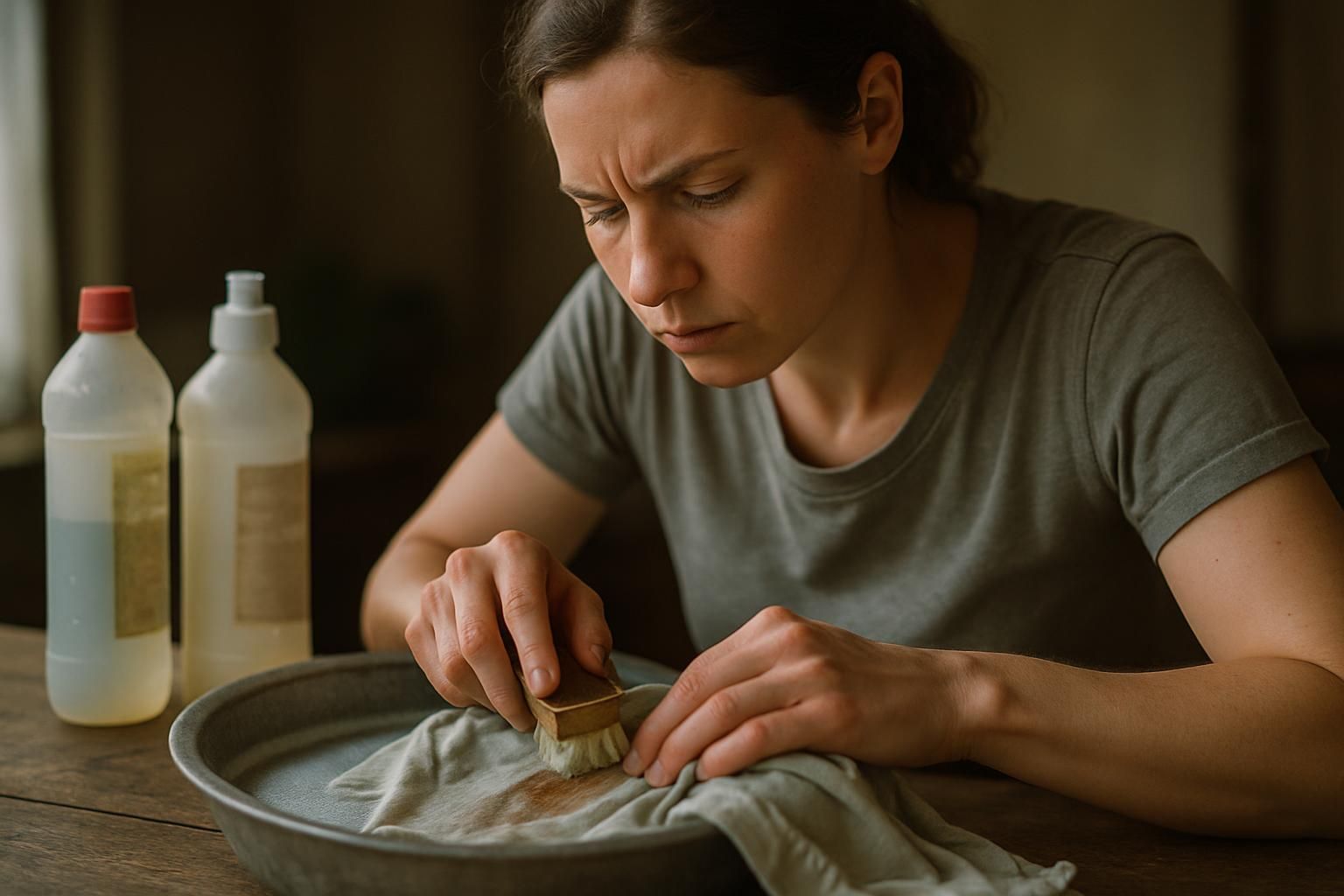
Smart habits turn a mess into a simple fix. A few rules protect colors and fibers.
Always test solvents on a hidden area
Different fabrics react differently. Test rubbing alcohol, paint thinner, or non-acetone nail polish remover on a tucked-away seam to spot color loss or texture changes before treating the stain.
If the fabric stays stable after five minutes, proceed. If not, switch methods or ask a pro for help.
Avoid using heat until the stain is removed
Heat makes stains stubborn by bonding pigments to fibers. Dryers, irons, and even hot rinses can set acrylic paint and latex paint firmly.
Air dry between attempts and rinse well after using solvents. Never apply heat until the area looks clean and smells free of chemicals.
Repeat steps if necessary
Hard stains sometimes need more than one pass. Alternate gentle scraping, soap, and the right solvent until progress shows.
Work in short rounds to protect the fabric. Patience here saves clothes from the rag pile.
What to Do If the Stain Persists
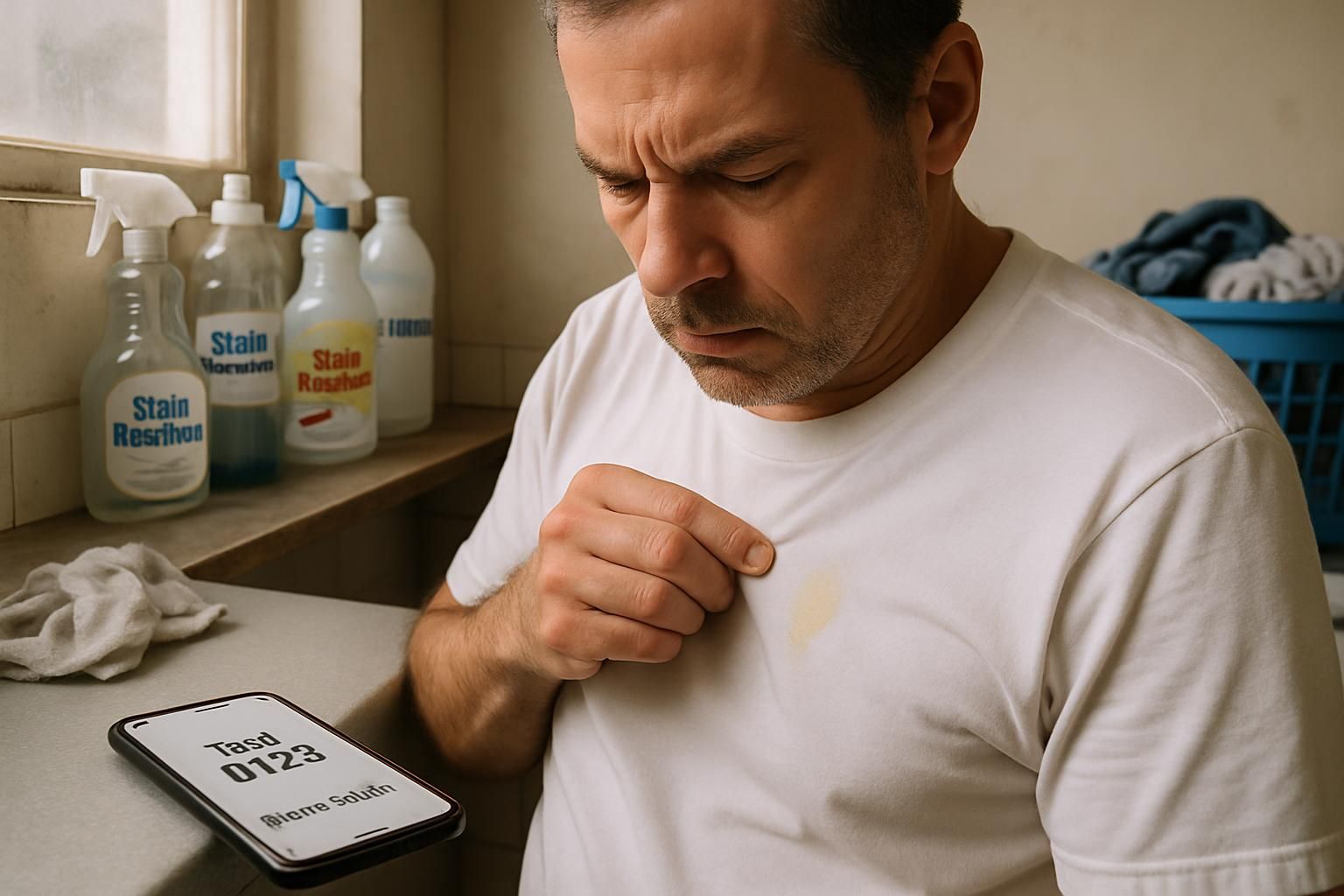
Some marks hang on even after careful work. That is normal with older stains or layers of paint.
Seek professional dry cleaning
Dry cleaners use special gear and dry-cleaning solvents that lift paint while protecting tricky fabrics. They are the safest choice for âdry clean onlyâ tags or delicate fibers like silk and wool.
Bring the item in quickly and point out the stain type if known. Fast, expert care often costs less than replacing a loved garment.
Consider fabric-safe paint removers
If home methods fell short, try fabric-safe removers from the laundry aisle. Products like Tide Ultra Stain Release Liquid Detergent and OxiClean MaxForce can help with both acrylic paints and latex paint on washable items.
Spot test first, then follow label directions. Isopropyl alcohol can lift dried acrylic on sturdy cotton. White spirit or acetone may work on oil-based paint on durable fabrics, but always check the care tag and rinse well.
Conclusion
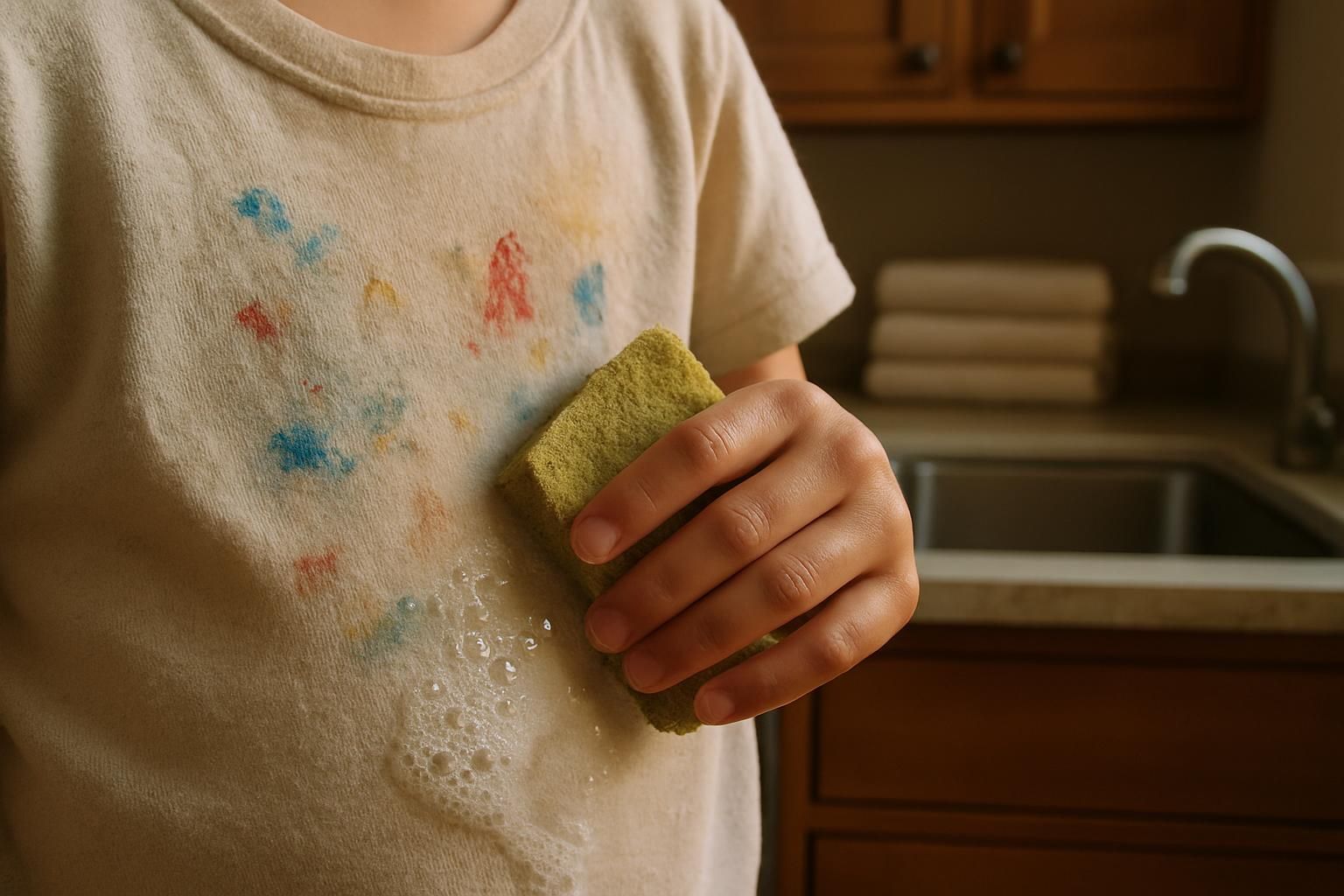
Paint stains are stressful, but a calm plan works. Check the care tag, identify whether it is water-based paint or oil-based paint, and act fast. Cold water and dish soap handle most fresh acrylic paint and latex paint messes.
Skip heat until the fabric is clear. If a stain sticks around, a dry cleaner can finish the job. With smart steps and everyday cleaning products, anyone can remove paint from clothes and save the outfit for next time.
FAQs
1. How do you remove water-based paint stains from clothes without harming the fabric?
Act fast. Rinse the spot with warm water while it is still wet. Dab gently, then use mild cleaning products if needed. Avoid scrubbing hard so you do not damage the fibers.
2. What is the safest way to get oil-based paint out of clothing?
First, blot off any extra oil-based paint with a paper towel or cloth. Apply a bit of rubbing alcohol to loosen what remains. Wash right away in warm water using laundry soap.
3. Can acrylic or latex paint be cleaned off fabric without ruining it?
Yes, but timing matters most for acrylic and latex paint stains. Scrape off dried bits carefully; soak the area in warm water mixed with gentle detergent before washing as usual.
4. Are there special tips for removing stubborn paint stains from clothes?
Try soaking tough spots in rubbing alcohol or specific cleaning products made for fabrics and paints; always test on a hidden patch first to keep your shirt safe from harm’s way!
Expert Tips and Additional Insights
When working to remove paint from clothes, follow these extra tips for both wet paint and dried paint. These guidelines help boost paint stain removal success.
For Wet Paint
- Immediately blot the excess paint with a paper towel. Then, flush the stain from the back with a forceful stream of warm or cold water to push the paint out.
- Apply a small amount of liquid dish soap or laundry detergent directly to the stain.
- Gently rub the cleaning product into the stain with your fingers or a toothbrush, then rinse thoroughly with cold water.
- Repeat this process until the stain is gone. Then, wash the garment in cold water using regular washing machine cycles.
For Dried Paint
- Carefully scrape off as much dried paint as possible. Soaking the area with warm water can help soften the paint.
- For water-based paint such as acrylic paint or latex paint, dab the stain using rubbing alcohol and scrub with a toothbrush to lift it.
- For oil-based paint stains, use a solvent like turpentine or paint thinner after performing a spot test.
- After the solvent loosens the paint, treat the area with a small amount of dish soap and let it soak if needed.
- Finally, wash the garment in the washing machine following the care instructions.
Important Considerations
- Always spot test any cleaning product or solvent on an inconspicuous area of the fabric to ensure it does not cause damage or discoloration.
- Treat the paint stain as soon as possible to improve the chances of complete removal.
- Avoid using heat from dryers or irons until you are sure the stain has been fully removed, as heat can set the stain permanently.
References
- https://www.milanartinstitute.com/blog/how-to-remove-paint-from-clothes
- https://www.whirlpool.com/blog/washers-and-dryers/how-to-get-dried-paint-out-of-clothes.html
- https://www.your-decorative-painting-resource.com/remove-paint-from-clothing.html
- https://www.wikihow.com/Get-Water-Based-Paint-Out-of-Clothes
- https://tide.com/en-us/how-to-wash-clothes/how-to-remove-stains/paint-stains (2024-02-27)
- https://home.howstuffworks.com/home-improvement/household-hints-tips/cleaning-organizing/how-to-get-paint-out-of-clothes2.htm
- https://www.hgtv.com/lifestyle/clean-and-organize/how-to-remove-paint-from-clothes
- https://www.lumberjocks.com/threads/how-to-remove-dried-paint-from-clothes.3874/
- https://www.homedepot.com/c/ah/how-to-get-paint-out-of-clothes/9ba683603be9fa5395fab9098acd3d7
- https://www.maytag.com/blog/washers-and-dryers/how-to-get-paint-out-of-clothes.html
- https://pubs.nmsu.edu/_c/C502.pdf






